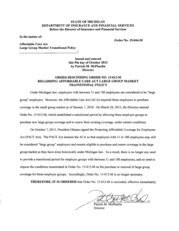Description
State of MI
MIChild
BCBSM
Benefits
Prosthodontics (fixed)
Federal Employee Plans
FEDVIP Dental
MetLife
Porcelain, ceramic and cast metal retainers for resin bonded fixed prosthesis
Oral & Maxillofacial Surgery
Simple extractions
No
Yes
Yes
Yes
Adjunctive General Services
Consultation by a second dentist not providing treatment
Yes
Yes
Exams and treatment for an emergency condition
Emergency treatment for temporary relief of pain
Yes
Yes
Yes
Yes
VISION
Federal Employee Plans
FEDVIP Vision
FEP BlueVision
Benefits
Yes
Glaucoma test is not specifically included or excluded
Yes
Yes
Yes
Vision exam and glaucoma test
Eyeglass frames (wire, plastic or metal)
Eyeglass lenses
Medically necessary contact lenses
June 16, 2015
26
.













